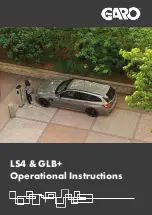
-
9 -
Setting of the Charging Program for Main Battery II Type (Design)
Use a small screw-driver to carefully move the
slide switch 4
behind the front panel of the unit to the desired
position for
battery II.
Also refer to connection plan (factory adjustment
"
II
<
I
" = starter battery).
Table 2:
If
charging port II is used,
2 different operating modes
are available for the integrated charging current
distributor for battery
II
.
The
total of the battery capacities
(Ah) should
not exceed
the max. "battery capacity
I
or
I+II
(depending on case of
application)" being indicated in the technical data.
Due to the low current intensity, auxiliary port III must
not
be considered for calculation.
Non-utilization
of charging port
II:
If terminal
II
is not used, the total capacity range is at disposal for battery
I
(master). Move the switch to factory-
adjustment ("below") "
II < I
" = starter battery.
Battery II
is of the
same type
(design/technology gel, AGM, acid or LiFePO4)
as battery I
.
Thus, it requires
the
same charging program as battery I
.
Application:
2 separate battery (banks)
for instance separate batteries for application and emergency.
The built-in
charging current distributor
charges
both batteries
with equal rights.
Automatic
charging begins with
the battery showing the lower charging state (I or II) with full charging current.
If the charging state of both batteries is identical, the respective second battery will be included, both batteries (I and
II) will be charged fully at the same time, and the charge will be conserved fully (trickle charge).
The charging currents will be distributed automatically in the correct ratio. Consequently, battery
I
and
II
may have
different capacity rates (Ah).
In this case,
the larger battery
should be connected to
charging port I (master)
.
The temperature equalization for battery
I
will also be applied to battery
II
.
Note: If required, the vehicle's starter battery is to be connected to the auxiliary port
III
12 V/2 A, 3A.
Charging program for battery
II
=
battery
I
. Also refer to charging programs 1) – 8)
"
II
<
I
" the
starter battery
of the vehicle is connected at charging port
battery
II
:
In case of need,
full charging current
is supplied to it by the built-in charging current distributor with an
own fixed
charging program
for starter batteries (high starting capacity, low water consumption and low maintenance
expenditure.
Application:
Intervention vehicles with
high load of the starter battery
due to additional consumer
loads with immediate start readiness.
The built-in charging current distributor
automatically
starts charging with
full charging current
of the battery
showing the lower charging state (I or II), with which also the
starter battery
will be charged
very quickly
up to
starting capacity
, in case of need (contrary to auxiliary port III).
After that, the respective second battery will be included and full charging of both batteries (I and II) will be effected
at the same time, whereas an
own charging program
(charging current, charging voltage, charging time) is active for
the
starter battery
, and the charging currents are distributed in the correct ratio. This applies also to the trickle
charge.
The different battery sizes (capacity rates, Ah) of the board battery at charging port
I
and of the starter battery at
charging port
II
are considered by the charger.
The batteries may also have a different design (acid, gel, AGM, LiFePo4 / lead starter battery).
A LiFePo4 board supply battery should be kept above 0°C to avoid a reduction of the charging currents in case of low
temperatures (battery protection).
Starter Battery Charging Program Battery
II
: IU1oU2oU3
U1 Full Charging:
14.2 - 14.4 V
1 - 3 h
U2 Full/Trickle Charging:
13.2 - 13.5 V
1 - 24 h
U3 Storage Charging:
13.1 - 13.2 V
Continuous


































